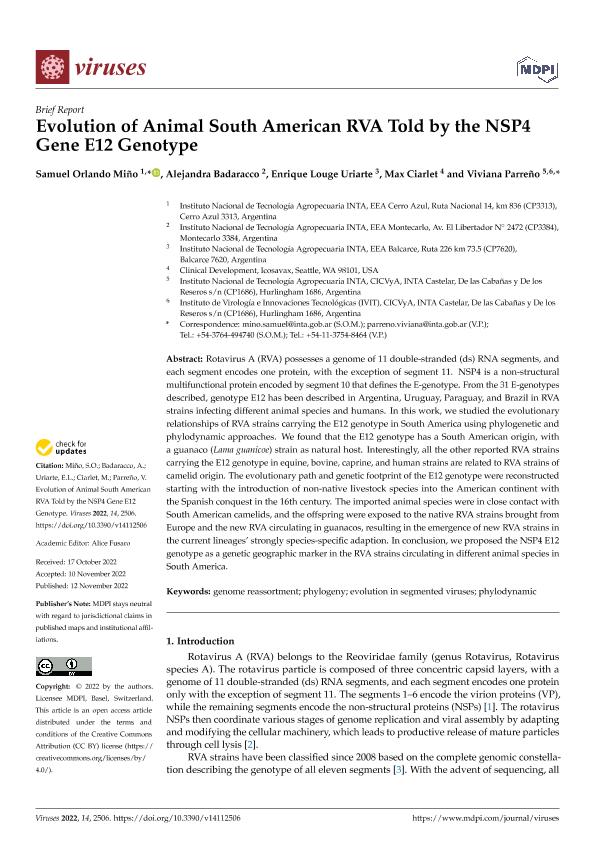Artículo
Evolution of Animal South American RVA Told by the NSP4 Gene E12 Genotype
Miño, Orlando Samuel; Badaracco, Alejandra ; Louge Uriarte, Enrique Leopoldo
; Louge Uriarte, Enrique Leopoldo ; Ciarlet, Max; Parreño, Gladys Viviana
; Ciarlet, Max; Parreño, Gladys Viviana
 ; Louge Uriarte, Enrique Leopoldo
; Louge Uriarte, Enrique Leopoldo ; Ciarlet, Max; Parreño, Gladys Viviana
; Ciarlet, Max; Parreño, Gladys Viviana
Fecha de publicación:
12/11/2022
Editorial:
MDPI
Revista:
Viruses
ISSN:
1999-4915
Idioma:
Inglés
Tipo de recurso:
Artículo publicado
Clasificación temática:
Resumen
Rotavirus A (RVA) possesses a genome of 11 double-stranded (ds) RNA segments, and each segment encodes one protein, with the exception of segment 11. NSP4 is a non-structural multifunctional protein encoded by segment 10 that defines the E-genotype. From the 31 E-genotypes described, genotype E12 has been described in Argentina, Uruguay, Paraguay, and Brazil in RVA strains infecting different animal species and humans. In this work, we studied the evolutionary relationships of RVA strains carrying the E12 genotype in South America using phylogenetic and phylodynamic approaches. We found that the E12 genotype has a South American origin, with a guanaco (Lama guanicoe) strain as natural host. Interestingly, all the other reported RVA strains carrying the E12 genotype in equine, bovine, caprine, and human strains are related to RVA strains of camelid origin. The evolutionary path and genetic footprint of the E12 genotype were reconstructed starting with the introduction of non-native livestock species into the American continent with the Spanish conquest in the 16th century. The imported animal species were in close contact with South American camelids, and the offspring were exposed to the native RVA strains brought from Europe and the new RVA circulating in guanacos, resulting in the emergence of new RVA strains in the current lineages' strongly species-specific adaption. In conclusion, we proposed the NSP4 E12 genotype as a genetic geographic marker in the RVA strains circulating in different animal species in South America.
Palabras clave:
EVOLUTION IN SEGMENTED VIRUSES
,
GENOME REASSORTMENT
,
PHYLODYNAMIC
,
PHYLOGENY
Archivos asociados
Licencia
Identificadores
Colecciones
Articulos (IVIT)
Articulos de INSTITUTO DE VIROLOGIA E INNOVACIONES TECNOLOGICAS
Articulos de INSTITUTO DE VIROLOGIA E INNOVACIONES TECNOLOGICAS
Articulos(CCT - NORDESTE)
Articulos de CTRO.CIENTIFICO TECNOL.CONICET - NORDESTE
Articulos de CTRO.CIENTIFICO TECNOL.CONICET - NORDESTE
Citación
Miño, Orlando Samuel; Badaracco, Alejandra; Louge Uriarte, Enrique Leopoldo; Ciarlet, Max; Parreño, Gladys Viviana; Evolution of Animal South American RVA Told by the NSP4 Gene E12 Genotype; MDPI; Viruses; 14; 11; 12-11-2022; 1-10
Compartir
Altmétricas



